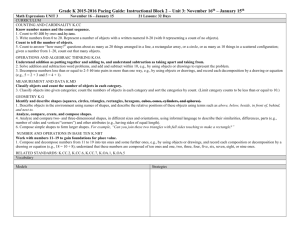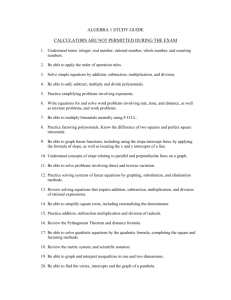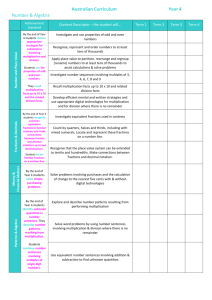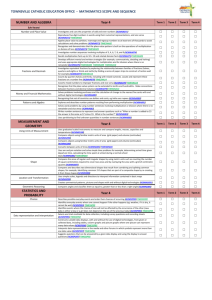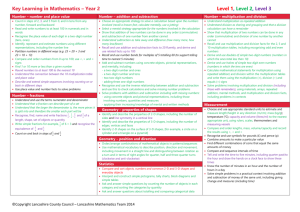curriculum pk-3
advertisement
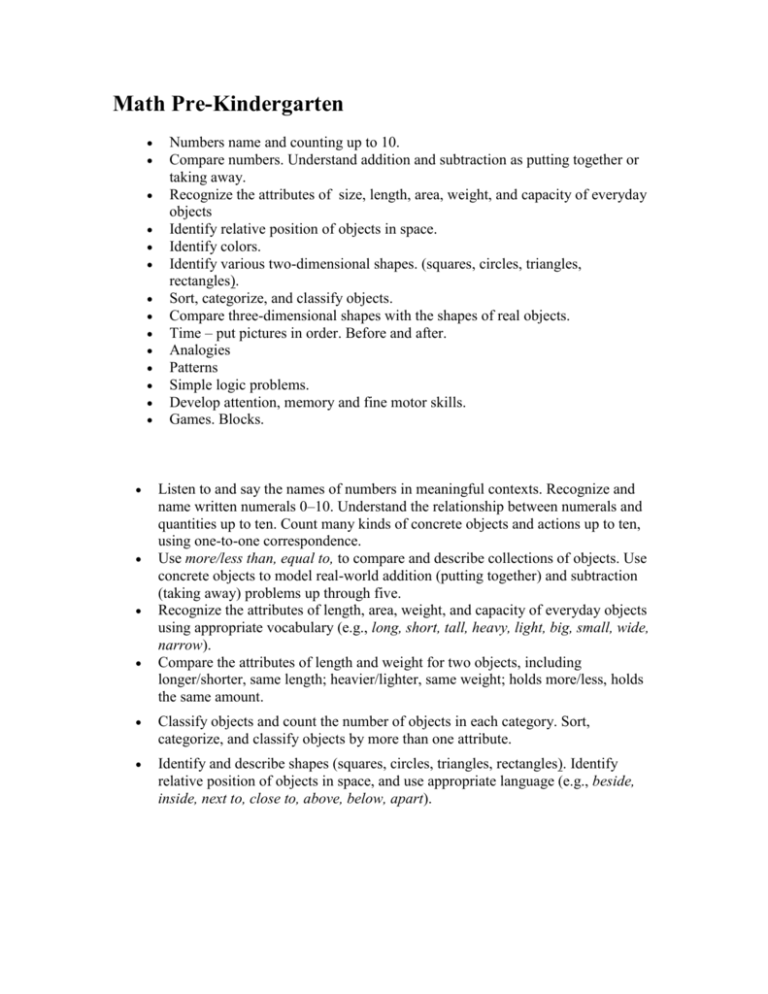
Math Pre-Kindergarten Numbers name and counting up to 10. Compare numbers. Understand addition and subtraction as putting together or taking away. Recognize the attributes of size, length, area, weight, and capacity of everyday objects Identify relative position of objects in space. Identify colors. Identify various two-dimensional shapes. (squares, circles, triangles, rectangles). Sort, categorize, and classify objects. Compare three-dimensional shapes with the shapes of real objects. Time – put pictures in order. Before and after. Analogies Patterns Simple logic problems. Develop attention, memory and fine motor skills. Games. Blocks. Listen to and say the names of numbers in meaningful contexts. Recognize and name written numerals 0–10. Understand the relationship between numerals and quantities up to ten. Count many kinds of concrete objects and actions up to ten, using one-to-one correspondence. Use more/less than, equal to, to compare and describe collections of objects. Use concrete objects to model real-world addition (putting together) and subtraction (taking away) problems up through five. Recognize the attributes of length, area, weight, and capacity of everyday objects using appropriate vocabulary (e.g., long, short, tall, heavy, light, big, small, wide, narrow). Compare the attributes of length and weight for two objects, including longer/shorter, same length; heavier/lighter, same weight; holds more/less, holds the same amount. Classify objects and count the number of objects in each category. Sort, categorize, and classify objects by more than one attribute. Identify and describe shapes (squares, circles, triangles, rectangles). Identify relative position of objects in space, and use appropriate language (e.g., beside, inside, next to, close to, above, below, apart). Math 0 (Kindergarten) Numbers name and counting up to 20. Number line. Zero. Count to 100 by ones and by tens. Compare numbers. Decompose numbers less than or equal to 10 into pairs in all possible ways (e.g., 5=5+0, 5 = 1 + 4, 5 = 2 + 3). Solve addition and subtraction word problems, and add and subtract within 10. Use number line. Separate numbers 11-19 in group of 10 and number from1 to 9. Identify and describe shapes. Compose simple shapes to form larger shapes. Compare objects by measurable attributes, such as length or weight Name relative positions of objects. Sort, categorize, and classify objects. Introduction to set. Analogies. Patterns. Simple logic problems. Develop attention, memory and fine motor skills. Games. Blocks. Write numbers from 0 to 20. Understand that the number of objects is the same regardless of their arrangement or the order in which they were counted. Count to 100 by ones and by tens. Count forward beginning from a given number Identify whether the number of objects in one group is greater than, less than, or equal to the number of objects in another group, e.g. Compare two numbers between 1 and 10 presented as written numerals Represent addition and subtraction with objects, number line, mental images, verbal explanations, expressions, or equations. Solve addition and subtraction word problems, and add and subtract within 10. Fluently add and subtract within 5. Directly compare two objects with a measurable attribute in common, to see which object has “more of”/“less of” the attribute, and describe the difference. For example, directly compare the heights of two children and describe one child as taller/shorter Compose and decompose numbers from 11 to 19 into ten ones and some further ones, e.g., by using objects or drawings, and record each composition or decomposition by a drawing or equation (e.g., 18 = 10 + 8); understand that these numbers are composed of ten ones and one, two, three, four, five, six, seven, eight, or nine ones. Describe objects in the environment using names of shapes, and describe the relative positions of these objects using terms such as above, below, beside, in front of, behind, and next to. Identify and describe shapes. (squares, circles, triangles, rectangles, hexagons, cubes, cones, cylinders, and spheres). Identify shapes as two-dimensional (lying in a plane, “flat”) or three-dimensional (“solid”). Analyze and compare two- and three-dimensional shapes, in different sizes and orientations, to describe their similarities, differences. Compose simple shapes to form larger shapes. Math 1 Different types of word problems involving addition and subscription up to 20. Place value: ones, tens. Graphic form of numbers larger then 10. Addition and subscription for numbers more then 20 without regrouping. Introduction to multiplication and division. Pifagore table. Simple word problems involving multiplication. Introduction to simple equations of the form x-a=b, x+a=b, a-x=b. Balance. Parts of a whole. Time Geometry. 3D geometry. Challenge analogies and patterns. Combinatory problems. Logic problems. Games. Blocks. Tangram Math 2 Place value: ones, tens, hundreds. Addition and subscription with regrouping. Different types of word problems involving several steps of addition and subscription. Expressions with variables - putting the basic word problems into expression form. Multiplication and division. Word problems involving multiplication. Simple equations of the form x-a=b, x+a=b, a-x=b, ax=b Order of operations Introduction to sets. Algoritms. Geometry. 3D geometry. Combinatorial problems. Logic problems. Zoom Math 3 Sets Order of operations , including parentheses Division with remainder. Long multiplication and division. Equations of the form ax+b=c and equations with parentheses Negative numbers Fractions Money (as a model for decimals) Angles Circus Special quadrilaterals. Perimeter and area. Logic. Algebra Sets. Union, intersection. Venn diagram. Word problems with Venn diagram. Order of arithmetic operations with parentheses. Division with remainder. Multiples and divisors. Long multiplication ( up to n digits to 2 digits). Long division with one or simple 2 digit divisor) Negative numbers. Negative and fractional numbers on the real line. Operations with negative numbers (addition and subtraction). Proper and improper fractions. Mixed numbers. Addition and subtraction of fractions; comparing fractions. Word problems and equations with fractions. Money as a model for decimals. Addition and subtraction. Word problems with money. Geometry Lines. Segments. Rays. Parallel and perpendicular lines. Measuring lengths and angles. Complementary and supplementary angels. Circus. Circumference Triangles: acute, etc. Sum of angles of a triangle. Special quadrilaterals: parallelogramm, rhombus, trapezoid. Perimeter and area of figures with can be split in quadrilateral with right angels. 3D geometry Extras Logic ( The Lady or the Tiger level)
